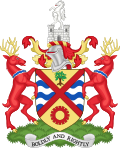Large parks
Foots Cray Meadows

Foots Cray Meadows is an area of parkland and woodland 100 hectares (240 acres) in size, and the largest open space in the borough. [2] It borders the suburbs of Albany Park, Sidcup, Foots Cray, North Cray and Ruxley. The River Cray runs through it in a north-easterly direction. The London Loop, a public recreational walking path around London, also known as the "M25 for walkers", runs through the meadows parallel to the river from Sidcup Place, just south of the meadows. The meadows contain two bridges across the River Cray: Five Arches bridge and the smaller Penny Farthing Bridge.
The Meadows are a Local Nature Reserve, [3] [4] and a Site of Metropolitan Importance for Nature Conservation. [5] They have also received a Green Flag Award. [6]
Danson Park
Danson Park is situated between Welling and Bexleyheath. At 75 hectares, [7] it is the second largest public park in the borough and the most used by the community. [7] Opened in 1925, it is often considered the finest green open space in the borough, [8] [7] and is Grade II listed on the Register of Historic Parks and Gardens. [9] [10]
Hall Place

The Hall Place estate is 65 hectares of landscaped gardens and grounds set around a 16th Century Grade I Listed stately home, including a topiary lawn, herb garden, tropical garden and long herbaceous cottage garden-styled borders. The gardens were first opened to the public in 1952 by Katharine, Duchess of Kent. Topiary replicas of the Queen’s Beasts were planted in 1953 to mark the coronation of Elizabeth II.
Hall Place is a Grade I listed Historic Park, [11] and has received a Green Flag Award for excellence in a public park or garden for 20 consecutive years from 1996 to 2016. [12] The site is maintained by the Bexley Heritage Trust. [11]
Lamorbey Park
Lamorbey Park is a 57-hectare (140-acre) park in Lamorbey, which was added to the Register of Historic Parks and Gardens of special historic interest in 1988. [13] Originally the estate consisted of 119 hectares belonging to William Steele, a director of the East India Company, but over time sections of the estate have been separated for other uses, including two secondary schools (Chislehurst and Sidcup Grammar School and Hurstmere School), Rose Bruford College, and Sidcup Golf Club. [13] The area of the park still in public ownership includes The Glade, a 7.4-hectare (18-acre) area of historic landscape laid in the 1920s with a large lake that houses the Lamorbey Angling Society. [14]
Other large parks

- East Wickham Open Space is a 28-hectare (69-acre) park in the north-west of the borough, situated between Welling and Plumstead. It was transferred from the Manor of Plumstead to the Borough of Bexley in 1902. [15] The site was used as a landfill site during the late 1950s, before being converted for use as a park. [15] The Green Chain Walk passes through the park, and it also contains a playground, and sports and skateboarding facilities. [15] A river named the Wogebourne passes under the northern part of the park in an underground culvert, but previously flowed above ground through it. [16] [17]
- Erith Marshes
- Franks Park is a 17-hectare (42-acre) park in Belvedere, [18] situated on the hill between the upper and lower parts of the town. It was formerly a part of the grounds of Belvedere Park, a property on Upper Park Road that was demolished in the mid-20th century. [18] [19] The area was purchased by Erith Council in 1920, and a park was established, named after Frank Beadle, a local man who donated funds towards the acquisition of the site. The park today has a wooded area with a substantial wildlife population, as well as a field and a playground. [19]
- Sidcup Place is a 16.3-hectare (40-acre) open green space situated between Sidcup High Street and Queen Mary's Hospital. [20] It extends from Frognal House to the east of the hospital, to The Green, an adjacent 0.12 hectares of parkland in front of the Manor House Registry Office, which contains Sidcup's War Memorial. [21] It contains a playground and tennis courts. [20]




